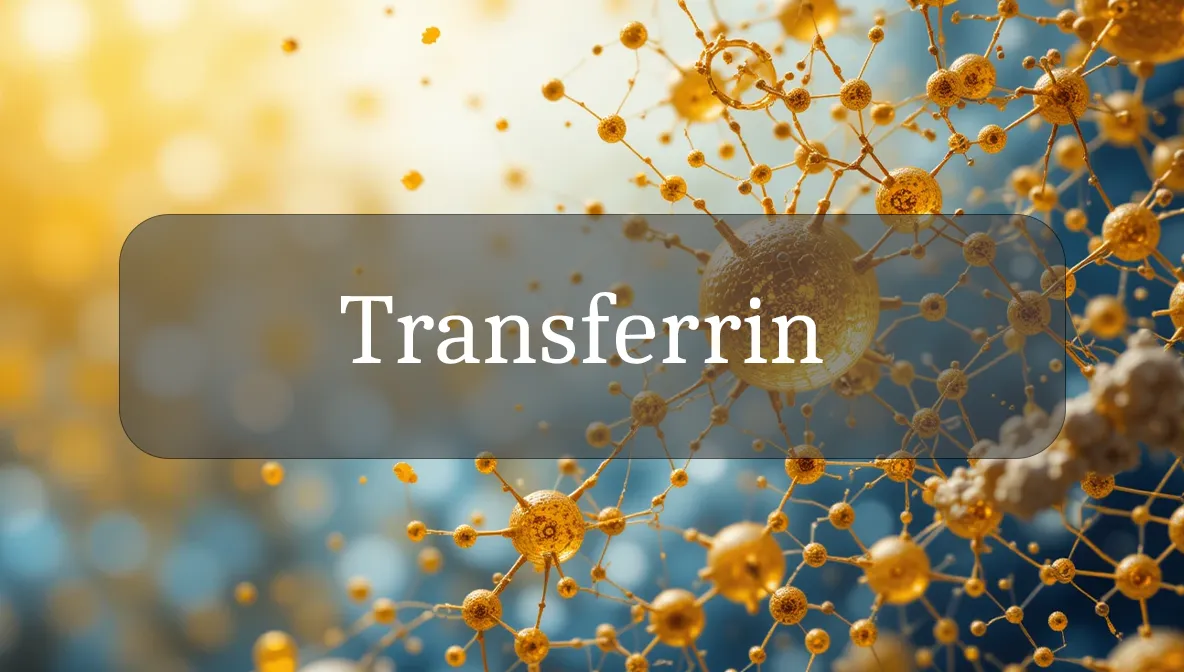Protein That Delivers Iron to Your Cells
Transferrin is like your body’s iron courier, a protein that transports iron through your blood to where it’s needed, keeping your cells energized and healthy. It’s a vital player in daily wellness, supporting oxygen delivery and cell growth. Let’s explore what transferrin is, how it benefits your health, and practical ways to support it—all in a clear, friendly way to empower your health choices.
Identity and Type
Transferrin is a structural protein and an essential protein, meaning your body produces it from amino acids in your diet, not something you consume directly. It’s a glycoprotein (a protein with sugar molecules attached) made in the liver and found in blood plasma. Transferrin binds iron tightly, acting as a shuttle to deliver it to cells. It’s rich in amino acids like glycine, lysine, and aspartic acid, and its structure allows it to carry two iron atoms at a time.
Biological Role and Health Benefits
Transferrin is your body’s iron manager, ensuring cells get the iron they need to thrive. Here’s how it supports your wellness:
- Iron Transport: Transferrin delivers iron to red blood cells for hemoglobin production, supporting oxygen delivery to tissues.
- Energy Production: By supplying iron to cells, it helps mitochondria (your cell’s powerhouses) produce energy.
- Cell Growth and Repair: Iron is essential for DNA synthesis and cell division, aiding tissue repair and growth.
- Immune Support: Transferrin limits free iron in the blood, starving harmful bacteria that need iron to grow, boosting your defenses.
- Anemia Prevention: It ensures iron is available for red blood cell production, preventing fatigue and weakness.
By managing iron, transferrin boosts your energy, resilience, and overall vitality.
Dietary Sources and Supplements
Your body makes transferrin in the liver using amino acids and nutrients from your diet. Top sources include:
- Lean Meats: Beef, chicken, turkey, and liver (rich in iron and amino acids).
- Fish and Seafood: Tuna, salmon, and oysters (high in iron and omega-3s).
- Eggs: A great source of amino acids for protein synthesis.
- Plant-Based Sources: Lentils, spinach, tofu, and fortified cereals (pair with vitamin C-rich foods to boost iron absorption).
- Nutrient Boosters: Iron (red meat, beans), vitamin C (oranges, bell peppers), vitamin B6 (bananas, chickpeas), and zinc (seeds, nuts) support transferrin production and function.
Iron supplements (8–18 mg daily, depending on age and sex) or protein powders (e.g., whey, 5–10 grams daily) may help if dietary intake is low. Aim for 0.8–1.2 grams of protein per kilogram of body weight daily (e.g., 56–84 grams for a 150-pound person).
Signs of Imbalance
Transferrin “imbalance” refers to abnormal levels or dysfunction, often due to nutrient deficiencies, liver issues, or health conditions. Signs include:
- Low Transferrin:
- Fatigue or weakness (due to poor iron delivery, leading to anemia).
- Pale skin or brittle nails.
- Shortness of breath or dizziness.
- High Transferrin:
- May indicate iron deficiency, causing similar symptoms like fatigue or pallor.
- Iron Imbalance: Low iron (anemia) or excess iron (hemochromatosis) can affect transferrin function, leading to energy loss or organ stress.
These signs may stem from iron deficiency, liver disease, chronic inflammation, or genetic conditions like hemochromatosis.
Supporting Optimal Levels or Function
To keep transferrin healthy and maintain its benefits, try these practical steps:
- Eat Iron-Rich Foods: Include heme iron (meat, fish) and non-heme iron (beans, spinach) with vitamin C (e.g., orange juice) to boost absorption.
- Boost Key Nutrients: Eat vitamin B6-rich foods (potatoes, tuna), zinc (pumpkin seeds, oysters), and protein sources (eggs, chicken).
- Support Liver Health: Reduce alcohol and processed foods; add liver-friendly foods like leafy greens, beets, and berries.
- Stay Hydrated: Drink 8–10 cups of water daily to support blood plasma and transferrin’s transport role.
- Get Enough Sleep: Sleep (7–9 hours) promotes liver health and protein production.
- Exercise Moderately: Activities like walking or yoga improve circulation and iron use without overtaxing the body.
- Avoid Iron Blockers: Limit coffee, tea, or calcium-rich foods during iron-rich meals, as they can reduce iron absorption.
Safety, Interactions, and Precautions
Transferrin is naturally produced and safe, but consider these points:
- Iron Overload: Too much iron (above 45 mg daily from supplements) can cause nausea, liver damage, or toxicity. Only supplement if prescribed.
- Liver Health: Conditions like cirrhosis or hepatitis can impair transferrin production, requiring medical management.
- Supplements: Iron or protein supplements are generally safe but may cause digestive upset (e.g., constipation from iron).
- Allergies: Supplements from fish or dairy may trigger allergies in sensitive individuals.
- Genetic Conditions: Hemochromatosis (excess iron) or atransferrinemia (rare transferrin deficiency) require specialized care.
- Medications: Some drugs (e.g., oral contraceptives) may affect transferrin levels. Consult your doctor if on long-term medications.
Fun Fact
Did you know transferrin is like a bodyguard for your iron? By tightly binding iron, it not only delivers it to cells but also keeps it away from bacteria that could use it to cause infections—talk about a double-duty protein!
Citations
- National Institutes of Health. (2023). Iron and blood health. MedlinePlus.
- Mayo Clinic. (2024). Nutrition for anemia and iron metabolism.
- Cleveland Clinic. (2022). The role of transferrin in iron transport.
- World Health Organization. (2020). Protein and amino acid requirements in human nutrition.
- USDA FoodData Central. (2023). Nutrient profiles for iron- and protein-rich foods.

